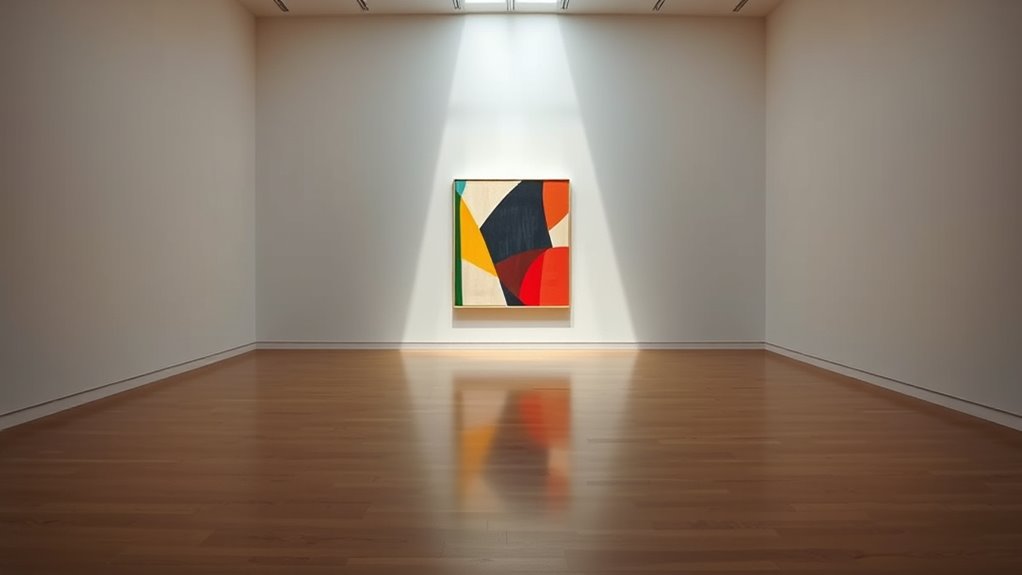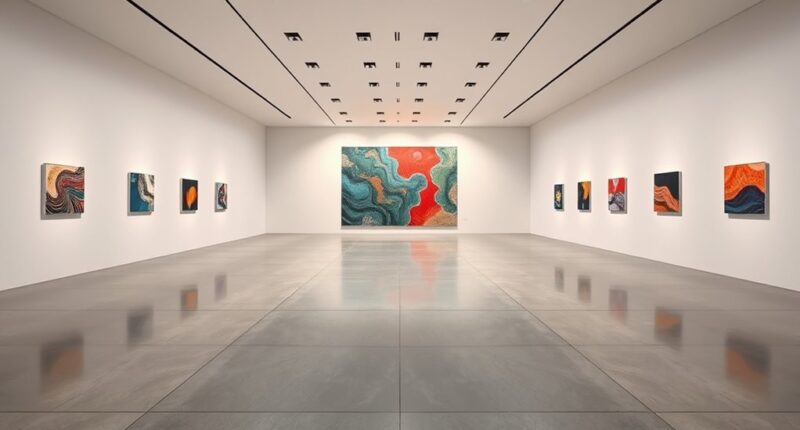To master art placement, use centerlines to create a cohesive and balanced display, aligning key pieces along a common axis at eye level. Consider sightlines to guide viewers naturally through the space, positioning art where it can be easily seen from main vantage points. Think strategically about visual weight and environment harmony to evoke emotion and craft an engaging experience. Keep exploring these principles, and you’ll reveal the secrets to transforming any space into a stunning gallery.
Key Takeaways
- Use a common centerline, typically at eye level (57-60 inches), to create visual cohesion in multiple artworks.
- Align artwork centers with sightlines from key vantage points to enhance viewing flow and engagement.
- Position art to complement furniture and architectural features, ensuring it feels integrated and balanced.
- Guide viewers’ eyes across the space by strategically placing art along natural sightlines.
- Balance visual weight and create rhythm by considering centerlines and sightlines for a harmonious display.

Have you ever wondered how the perfect art placement can transform a space from ordinary to extraordinary? The secret lies in understanding and harnessing the power of centerlines and sightlines. When you approach art placement with a strategic eye, you don’t just hang pictures; you craft an experience that guides the viewer’s eye effortlessly and evokes emotion. It’s about knowing where to position each piece so it becomes part of a visual dialogue, not just a decorative afterthought.
Start by considering the natural eye level—the height where your gaze naturally falls when standing or seated. This is your baseline for creating effective sightlines. For most art, that means centering the piece between 57 and 60 inches from the floor. But don’t treat this as a rigid rule; think about the context. For example, if you’re hanging art above a sofa, aim to position it so the center of the piece aligns with the top of the furniture or slightly above it. This ensures the artwork feels integrated rather than floating awkwardly. In a hallway or corridor, follow the eye level as you walk through, creating a seamless visual flow that invites engagement.
Next, consider the concept of the centerline—the imaginary vertical or horizontal axis where your eye naturally focuses. When hanging multiple pieces, establish a common centerline to create cohesion. For instance, if you’re assembling a gallery wall, align the centers of each frame along an invisible line that runs at eye level. This creates a harmonious rhythm, preventing the display from feeling chaotic or disjointed. If you’re working with large-scale art or installations, think of the centerline as the anchor point that establishes balance within the space. It’s your anchor, your compass, guiding the placement to ensure everything feels intentional.
Sightlines aren’t just about where you hang art; they’re about the experience of viewing it. Imagine walking into a room and immediately being drawn to a particular piece because it’s placed along a natural sightline. You want to position art so it’s easily viewable from key vantage points—entryways, seating areas, or frequently traveled paths. Avoid placing artwork where it’s obscured by furniture or architectural features. Instead, aim for sightlines that allow your eye to naturally travel across the space, stopping at each piece with curiosity and appreciation.
Additionally, paying attention to visual weight helps balance the composition, ensuring the arrangement feels stable and pleasing. Imagine walking into a room and immediately being drawn to a particular piece because it’s placed along a natural sightline. You want to position art so it’s easily viewable from key vantage points—entryways, seating areas, or frequently traveled paths. Avoid placing artwork where it’s obscured by furniture or architectural features. Instead, aim for sightlines that allow your eye to naturally travel across the space, stopping at each piece with curiosity and appreciation.
In the end, mastering art placement through centerlines and sightlines transforms your space into a curated gallery. It’s about creating a visual rhythm, guiding the eye, and cultivating an environment where art isn’t just decoration but an integral part of the experience. When you pay close attention to these details, you craft a space that feels both harmonious and dynamic—an environment that invites exploration and sparks inspiration at every turn.
Frequently Asked Questions
How Do Lighting Conditions Affect Sightlines in Art Placement?
Lighting conditions directly influence your sightlines by creating contrast and shadows that guide your eye or obscure details. Bright lighting highlights key features, making art more accessible, while dim or uneven lighting can distort perception or cause glare. You should strategically position light sources to enhance viewing angles, avoid reflections, and guarantee the artwork remains clear from various vantage points, allowing viewers to fully appreciate the piece without strain or distraction.
What Are Common Mistakes to Avoid With Centerline Alignment?
You should avoid misaligning the centerline, as it can create visual imbalance and distract viewers. Double-check measurements and use a level or laser to guarantee perfect alignment. Don’t rely solely on eyeballing; subtle shifts can throw off the entire composition. Also, consider the viewer’s line of sight—avoid placing key pieces too high or low. Precision and consistency are your best tools for achieving a harmonious, impactful display.
How Does Wall Texture Influence Artwork Positioning?
Wall texture impacts how your artwork appears and should guide your positioning. If the wall is rough or uneven, avoid hanging art directly on the textured surface; instead, use a stable backing or mount on a smooth section. Consider how light interacts with the texture, and adjust the height to minimize glare or shadows. Strategically, you’ll want your piece to stand out without being distorted or lost against the wall’s tactile qualities.
Can Art Placement Techniques Vary by Room Function?
You can definitely vary your art placement techniques based on room function. Imagine a cozy living room where you hang a large, inviting piece at eye level, welcoming guests into warmth and conversation. In contrast, a hallway might feature smaller, strategically placed artworks to guide the eye along the corridor’s length. By tailoring your approach, you enhance each space’s purpose, creating a harmonious flow that invites exploration and comfort.
What Tools Help Measure Sightlines Accurately?
You can use a laser distance meter or a digital protractor to measure sightlines accurately. These tools help you pinpoint exact angles and distances, ensuring your artwork isn’t obstructed. By strategically aligning your measurements with the viewing eye level, you create a visual flow that guides viewers effortlessly. Precision tools like these empower you to craft a harmonious space where art and sightlines coexist seamlessly, enhancing overall aesthetic impact.
Conclusion
To truly master art placement, think of your space as a finely tuned orchestra where centerlines and sightlines are the conductor’s baton. When you align your artwork thoughtfully along these guiding lines, you orchestrate a visual harmony that draws viewers in like a magnet. Remember, each piece isn’t just hanging—it’s an integral note in your design symphony. With strategic placement, your art transforms from mere decoration into a engaging focal point that resonates deeply.








